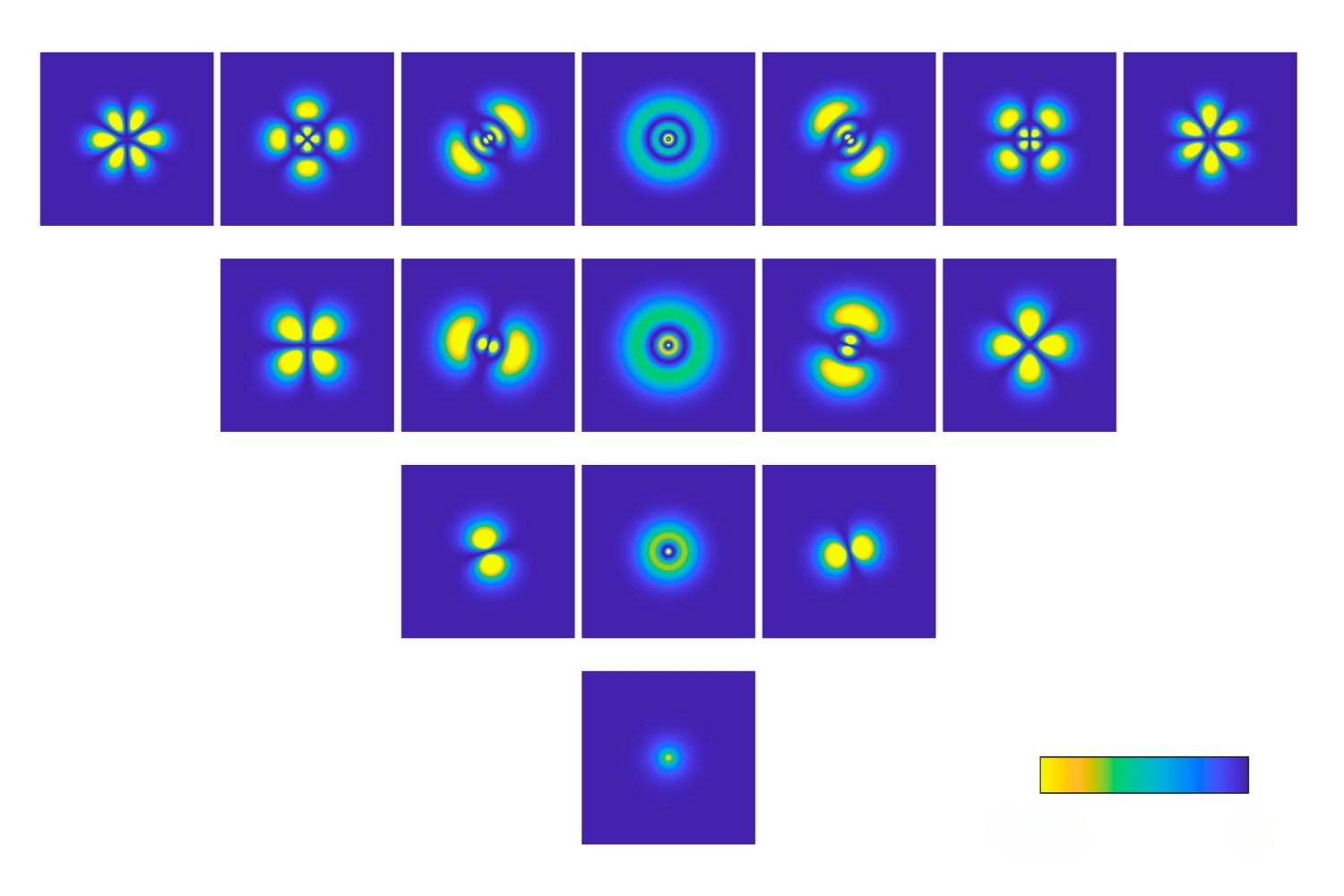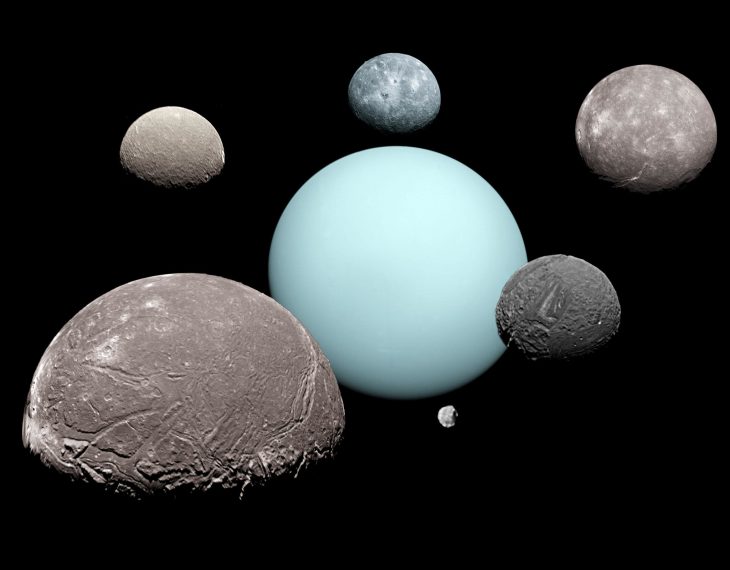
Uranus is a unique planet in more ways than one. For instance, it’s the only planet that rotates on its side, earning it the nickname “the sideways planet”. It’s also the coldest planet in the Solar System despite it not being the furthest away from the Sun. Although Uranus has recently become the butt of many schoolyard jokes, it’s a planet that holds many wonders. Take a closer look at the sideways planet with these Uranus facts.
- 01Uranus has a mass that’s 14.5 times greater than the Earth.
- 02The planet spans 31,763 mi (51,120 km) in diameter, which is four times wider than the Earth.
- 03People have seen Uranus as early as 128 BC.
- 04The average distance of Uranus from the Sun is around 20 astronomical units (2 billion mi; 3 billion km).
- 05Johann Bode first proposed the name Uranus in 1782.
- 01Uranus is the seventh planet from the sun, in between Saturn and Neptune.
- 02It’s also known as The Sideways Planet.
- 03Similar to Earth, it is an oblate spheroid.
- 04Uranus is a planet that is blue-green in color.
- 05John Flamsteed is credited for its first definite sighting. He classified Uranus as a star in 1690.
- 06Uranus’ atmosphere is mostly composed of hydrogen and helium, along with methane and traces of water and ammonia.
- 07Its blue-green coloration is the result of the presence of methane in its atmosphere. Methane is good at absorbing red light.
- 08It takes 2 hours and 40 minutes for light to travel from the Sun to Uranus.
- 09In Chinese, Japanese, Korean and Vietnamese languages, their name for Uranus translates to “sky king star.”
- 10It shares roughly the same chemical composition as Neptune.
- 01Uranus was the first planet discovered outside of Earth using a telescope.
- 02Its most recent equinox occurred on December 7, 2007, and the next equinox will occur in 2028.
- 03Uranus can fit 63 Earth-sized planets inside it.
- 04The planet Uranus was discovered before Antarctica.
- 05Uranus is slightly larger than Neptune but has a lesser mass.
Uranus Facts Infographics
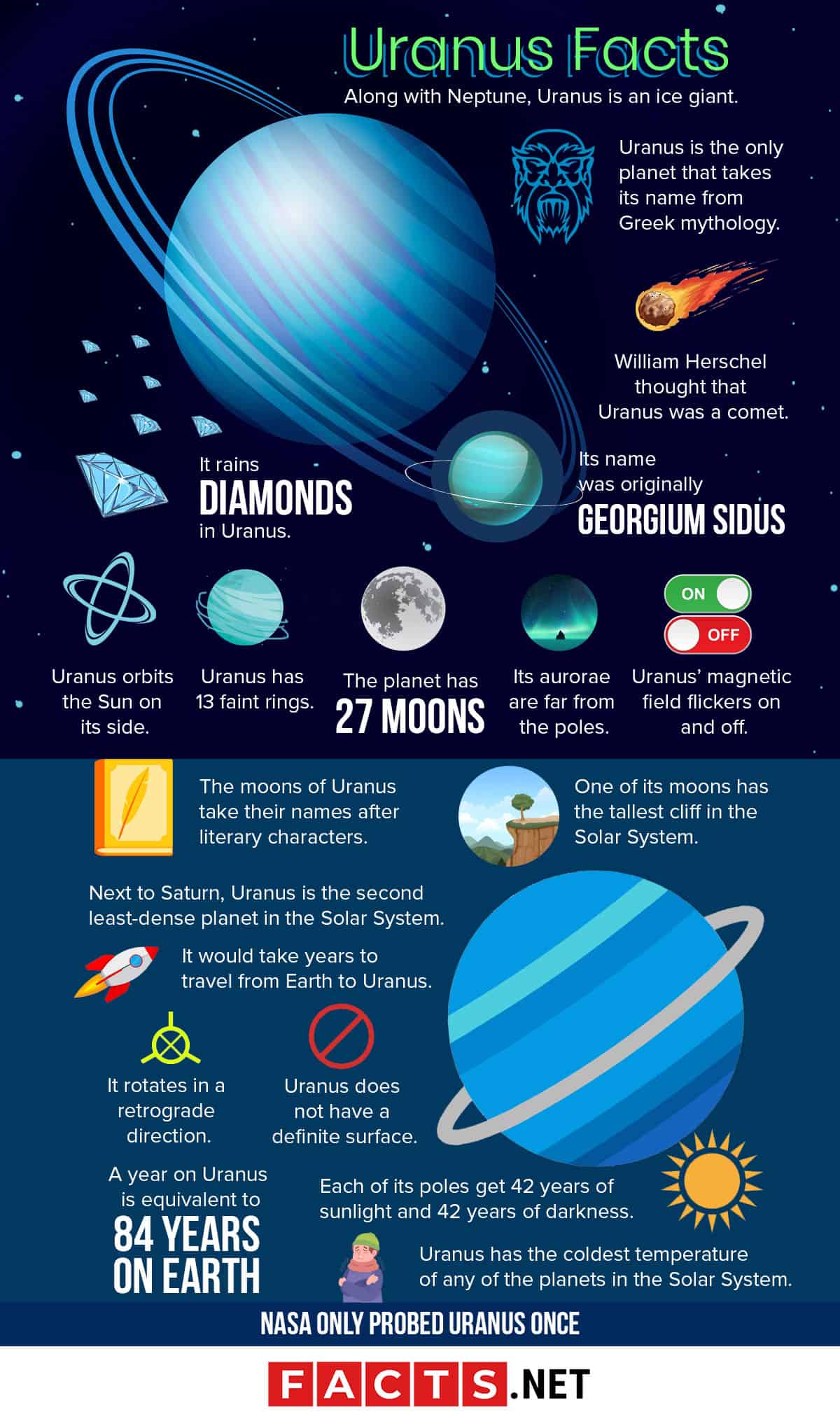
It rains diamonds in Uranus.
On Uranus, the planet’s constant pressure causes its atmosphere’s abundance of methane to break down. The resulting carbon atoms condense into diamond crystals that rain like hailstones through the planet’s mantle. Due to their similar conditions, the same phenomenon happens with Jupiter, Saturn, and Neptune.
Interestingly, scientists also suggest that the mantle of Uranus has an ocean of liquid diamond, with solid “diamond-bergs” floating around instead of icebergs. How’s that for amazing Uranus facts?
Along with Neptune, Uranus is an ice giant.
Unlike the gas giants Jupiter and Saturn, which are mostly made up of hydrogen and helium, ice giants such as Neptune and Uranus are made up of elements heavier than hydrogen and helium. Uranus is mostly made up of ices, which are compounds that have freezing points above roughly 100 K. The primary ices that make up Uranus are ammonia, water, ammonium hydrosulfide, and methane hydrate.
Uranus has the coldest temperature of any of the planets in the Solar System.
Even though Neptune is more distant from the Sun, Uranus has the coldest temperature of all the planets in the Solar System. Due to Uranus having very little internal heat to complement the heat from the Sun, its atmosphere has a minimum temperature of 49K (-224.2°C; -371.56°F).
Uranus is the only planet that takes its name from Greek mythology.
Unlike all the other planets named after figures in Roman mythology, Uranus borrows its name from Greek mythology. The planet takes its name after the Greek deity Ouranos, the primordial god of the sky. Ouranos, or Uranus, is the father of Cronus (Greek counterpart for Saturn) and the grandfather of Zeus (Greek counterpart of Jupiter).
The adjectival form of Uranus is “Uranian,” which is used to describe something related to the planet. Astronomers prefer to pronounce “Uranus” with a stress on the first syllable and a short “a” sound.
William Herschel thought that Uranus was a comet.
Upon his observation of Uranus in 1781, Sir William Herschel thought that Uranus was a comet or a star. Sharing his findings to other astronomers, Uranus’ odd movement and lack of a tail led them to believe that it was neither a comet nor a star.
It was only until the astronomer Anders Johan Lexell computed its orbit that Uranus got confirmed as a planet. Two years after its discovery, everyone agreed that Uranus was a planet.
Its name was originally Georgium Sidus.
When he first discovered Uranus, William Herschel had the honor of naming the heavenly body. Herschel named it Georgium Sidus, Latin for “George’s Star”, or the “Georgian Planet.” to honor his patron, King George III. However, King George III was not popular outside of Britain.
Thus, others suggested alternative names such as Herschel, Neptune, and even Neptune Great Britain. It wasn’t until 70 years after its discovery that the name Uranus, proposed by Johann Elert Bode, became universally accepted.
Uranus orbits the Sun on its side.
One of the Uranus facts that you can’t miss is that it orbits the Sun while rotating on its side, earning it the nickname “the sideways planet.” Uranus’ equator stands nearly at a right angle from the plane of its orbit, making it appear to rotate on its side. This odd planet has an axial tilt of 97.77 degrees. While still unconfirmed, many astronomers explain Uranus’ tilt as the result of an Earth-sized protoplanet crashing into Uranus when the Solar System first formed.
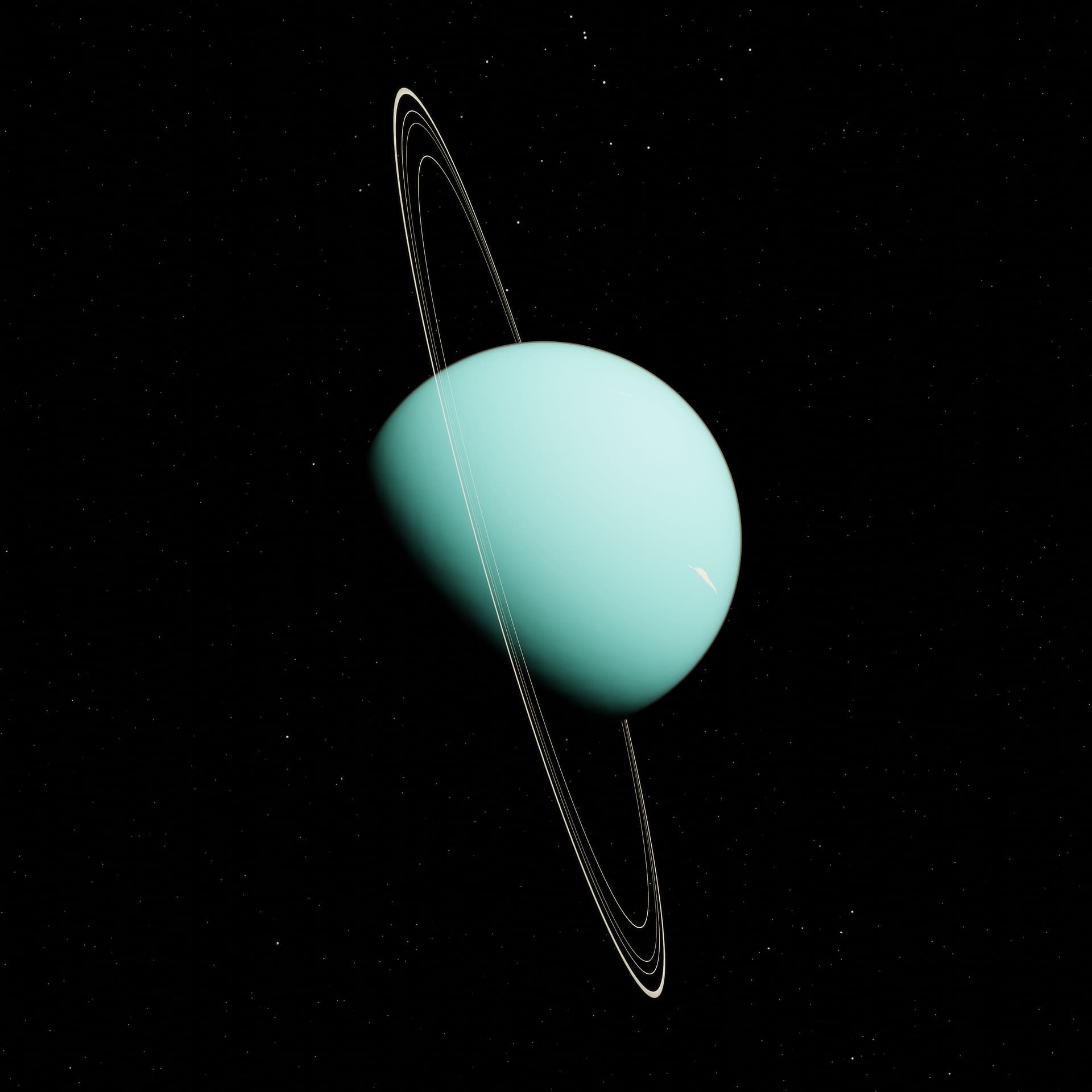
Uranus has 13 faint rings.
Although Uranus appeared nearly featureless when Voyager 2 photographed it, Uranus actually has 13 distinct rings that surround the planet. The brightest ring is the epsilon ring, with all but two rings only measuring a few kilometers wide. Scientists suggest that the rings formed due to parts of moons that have been shattered over time.
The planet has 27 moons.
Uranus has a total of 27 moons, which are classified into three groups: 5 major moons, 9 irregular moons, and 13 inner moons. Interestingly, some moons show signs of volcanic activity and canyon formations.
The five major moons of Uranus are Ariel, Miranda, Oberon, Titania, and Umbriel. Of all these moons, Titania is the largest, spanning 980.5 miles (1,578 km) in diameter. While it measures less than half of Earth’s moon, Titania remains the eighth-largest moon in the Solar System.
The moons of Uranus take their names after literary characters.
William Herschel discovered the Uranian moons Titania and Oberon in 1787, but the said moons did not receive their names until the year 1852. William’s son, John Herschel, took the liberty of naming the Uranian moons. Instead of opting for the conventional names derived from Greek mythology, Herschel named them after spirits in English literature—mostly the works of William Shakespeare and Alexander Pope.
One of its moons has the tallest cliff in the Solar System.
Uranus’ moon, Miranda houses the tallest known cliff in the Solar System. Called Verona Rupes, the cliff stands around 12 mi (20 km) high. Since Miranda’s gravity is relatively low, it would take a person around 12 minutes to fall from the top of the cliff to the bottom, at a speed of around 124.27 mph (200 km/h).
Next to Saturn, Uranus is the second least-dense planet in the Solar System.
Although Uranus is large, it packs a relatively small amount of mass. It has a density of 1.27 g/cm3 and is the second-least dense planet in the Solar System, next to Saturn.
NASA only probed Uranus once.
To date, only one exploration of the planet Uranus has been done up close. This was through the probe of NASA’s unmanned spacecraft, Voyager 2, which made its closest approach to the planet on January 24, 1986. Any other exploration of Uranus has only been done through telescopes.
Uranus’ magnetic field flickers on and off.
While the Earth’s magnetic field aligns with its poles, Uranus’ magnetosphere tends to tumble around the planet, tipped nearly 60° from the planet’s axis of rotation. This magnetic field also flickers on and off as the lines disconnect and reconnect with the planet’s rotation.
Its aurorae are far from the poles.
Similar to other planets, Uranus also experiences aurorae, much like our own Northern Lights. However, Uranus’ aurorae appear farther from the planet, since its magnetic poles lie further apart.
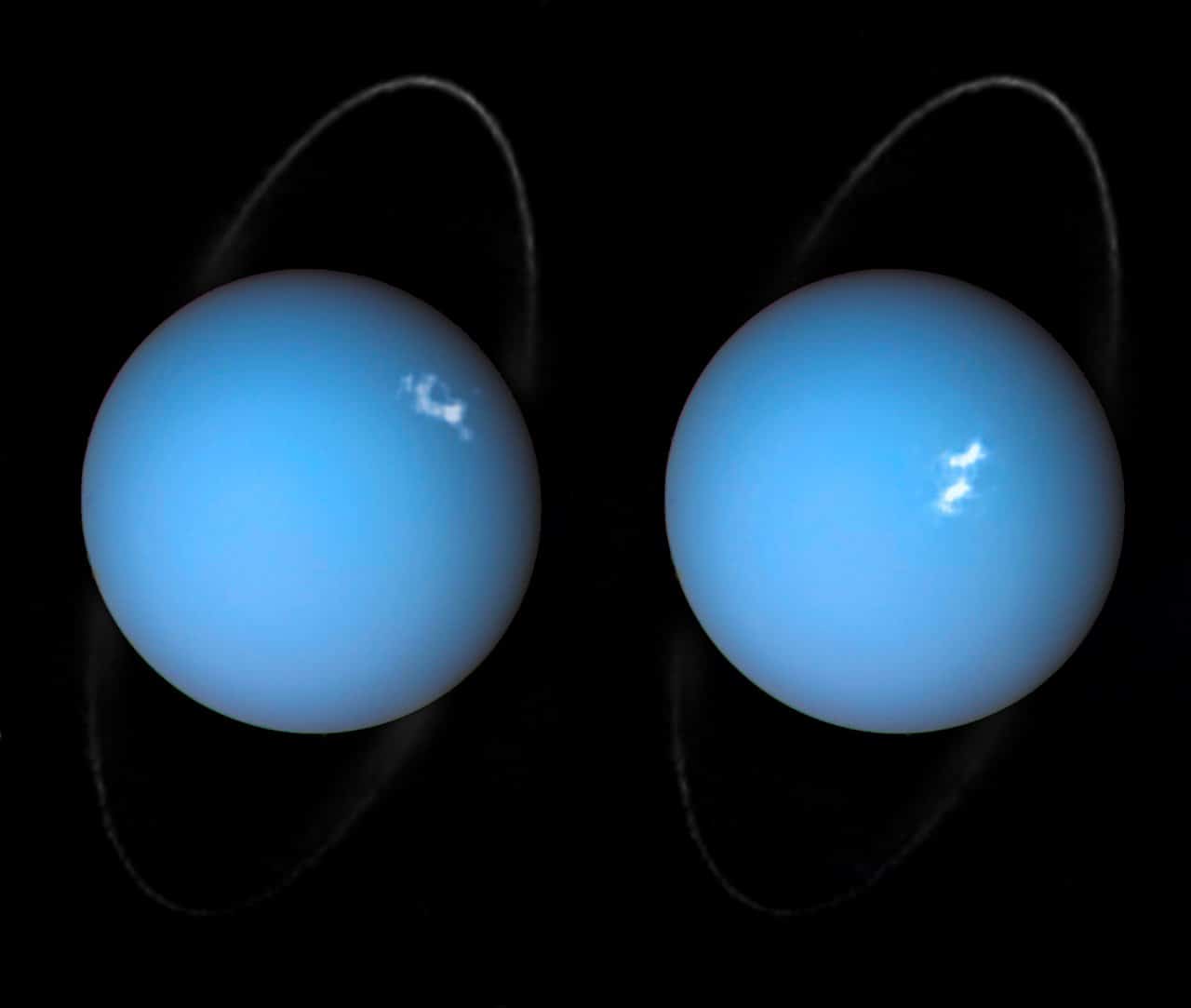
It would take years to travel from Earth to Uranus.
Since the solar system is always in motion, the distance between Earth and Uranus changes constantly. Generally speaking, Earth and Uranus could be as close as 1.6 billion miles (2.6 billion kilometers) and as far as 1.98 billion miles (3.2 billion km) apart. For one, it took NASA’s Voyager 2 spacecraft around nine and a half years to get to Uranus since its launch from Earth.
It rotates in a retrograde direction.
Uranus rotates sideways, but it also rotates in a retrograde direction, similar to Venus. Looking at its north pole, both Uranus and Venus rotate in a clockwise motion instead of counterclockwise like all the other planets.
Uranus does not have a definite surface.
Similar to gas giants, the ice giant Uranus is mostly composed of fluids with no definite solid surface. However, a spacecraft would be unable to land on the planet because of its immense pressure.
Today, scientists can only distinguish between the atmosphere of Uranus and its surface by determining its pressure. As long as a given area’s pressure exceeds one bar (the pressure of Earth at sea level), they would count it as the planet’s “surface.”
Each of its poles get 42 years of sunlight and 42 years of darkness.
One of the most outstanding Uranus facts is that because of the tilted orientation of Uranus, its poles experience unusual seasons. During spring and fall, each of its poles experiences 42 years of day and 42 years of night. Meanwhile, its north pole gets 21 years of darkness in the winter and 21 years of sun in the summer.
A year on Uranus is equivalent to 84 years on Earth.
Uranus takes about seven years to pass through each of the zodiac constellations. The planet orbits completely around the Sun once every 84 Earth years. Since William Herschel’s discovery of the planet in 1781, it has revolved around the sun twice and is bound to complete its third orbit in 2033.
Uranian days are shorter than Earth days.
While it revolves at an extremely slow rate, Uranus rotates at a rather quick pace. In total, the interior part of Uranus completes a full rotation at about 17 hours and 14 minutes.
Uranus has a small, rocky core.
According to the standard model of Uranus’ structure, the planet has three layers: an outer envelope composed of hydrogen and helium, an icy mantle, and a rocky core. Comprising around 20% of the planet’s radius, the planet’s core mostly consists of silicate and iron–nickel alloys.
Its surface gravity is weaker than that of the Earth's.
This is certainly one of the more unexpected Uranus facts out there. Although Uranus is far larger than Earth, its surface gravity is much weaker than that of the Earth’s. To compare, its surface gravity is 8.69 m/s2, while the Earth has a surface gravity of 9.807 m/s2.
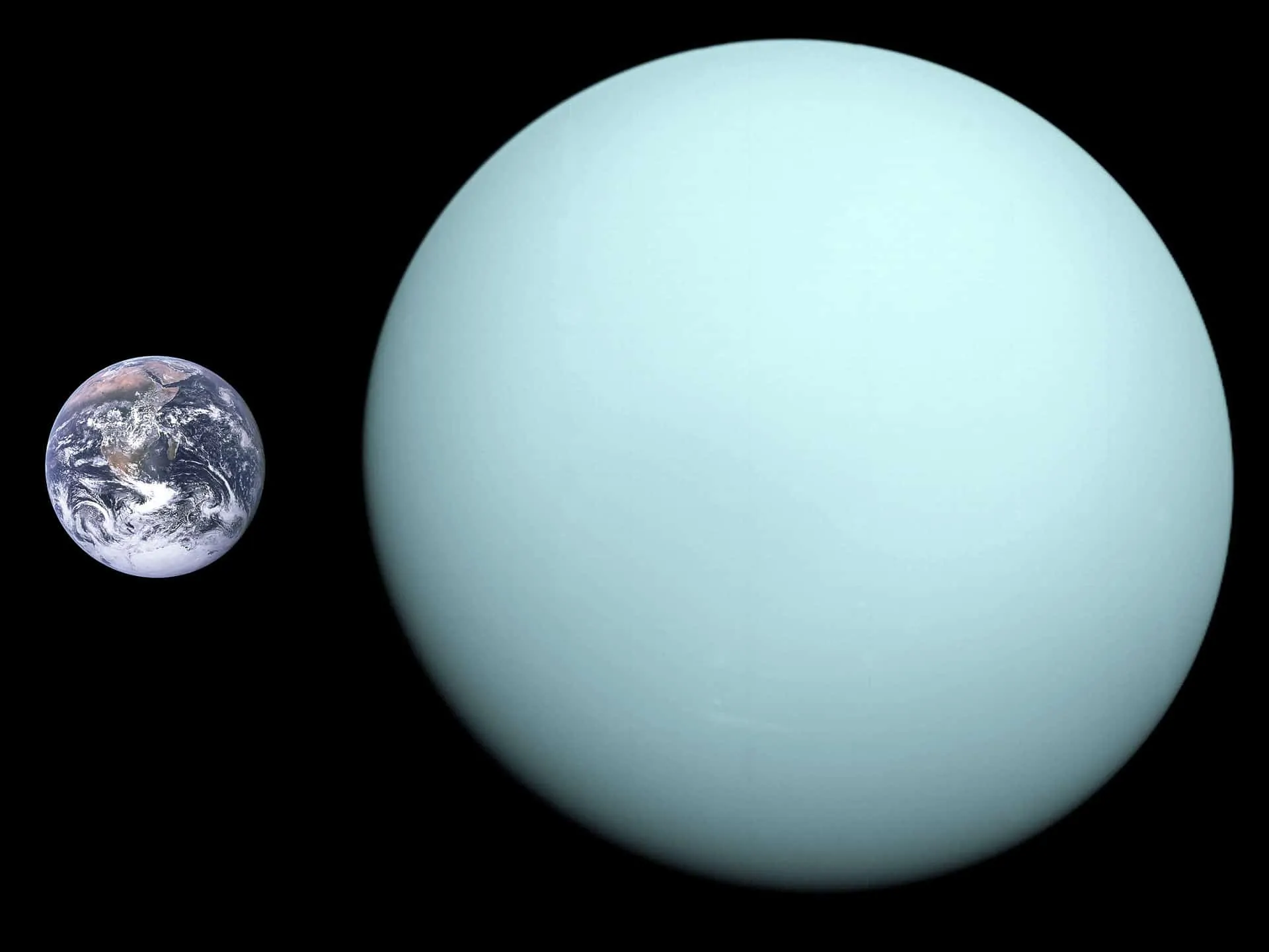
Uranus and Neptune switched places 4 billion years ago.
In the Solar System, Neptune is the planet that lies farthest from the Sun, followed by Uranus. However, it wasn’t always this way. According to recent models, Uranus and Neptune actually switched places about 4 billion years ago.
Wind speeds in Uranus can reach up to 560 miles per hour.
Although Uranus looks plain compared to the other giant planets, it still experiences interesting weather conditions. As a windy planet, Uranus experiences different flows of wind throughout its surface, reaching speeds up to 559 miles per hour (250 m/s; 900 km/h). In comparison, the highest recorded surface wind speed on Earth only reached 320 miles per hour (142 m/s; 510 km/h)—and that was because of a tornado.
Its atmosphere has three layers.
The atmosphere of Uranus has three distinct layers: the troposphere, stratosphere, and thermosphere. The troposphere is its innermost layer, while the thermosphere is the outermost level. Unlike the Earth, Uranus does not have a mesosphere.
Uranus can be seen without binoculars.
Along with Mercury, Venus, Mars, Jupiter, and Saturn, you can also see the planet Uranus with the naked eye. With an apparent magnitude of +5.7, Uranus is relatively dim compared to other objects in the sky, but it is visible on dark, clear nights.
Similar to Neptune, Uranus has a great dark spot.
When Voyager 2 photographed Uranus, it was almost featureless, appearing mostly as a pale blue ball against the darkness of space. However, the probe did detect a great dark spot on its surface.
This dark spot is the result of churning winds in the atmosphere of Uranus, spanning 1,100 miles (1,770 km) by 1,900 miles (3,058 km). If you have a hard time picturing that, this vortex is large enough to cover two thirds of the United States.
The chemical element uranium takes its name after the planet.
In 1789, the German chemist Martin Klaproth discovered the chemical element Uranium and named it after the planet Uranus. Prior to the element’s discovery, Herschel discovered the planet just eight years before.
Uranus could potentially be a mining site for helium-3.
Although atmospheric mining has never been done before, scientists plan to mine valuable gases such as hydrogen and helium from the atmospheres of extraterrestrial planets.
One of the best candidates for mining helium-3 is Uranus, which has a small gravity well and an abundance of the material. Helium-3 is an isotope of helium that can be used for cryogenics, medical imaging, and nuclear propulsion.
Was this page helpful?
Our commitment to delivering trustworthy and engaging content is at the heart of what we do. Each fact on our site is contributed by real users like you, bringing a wealth of diverse insights and information. To ensure the highest standards of accuracy and reliability, our dedicated editors meticulously review each submission. This process guarantees that the facts we share are not only fascinating but also credible. Trust in our commitment to quality and authenticity as you explore and learn with us.


